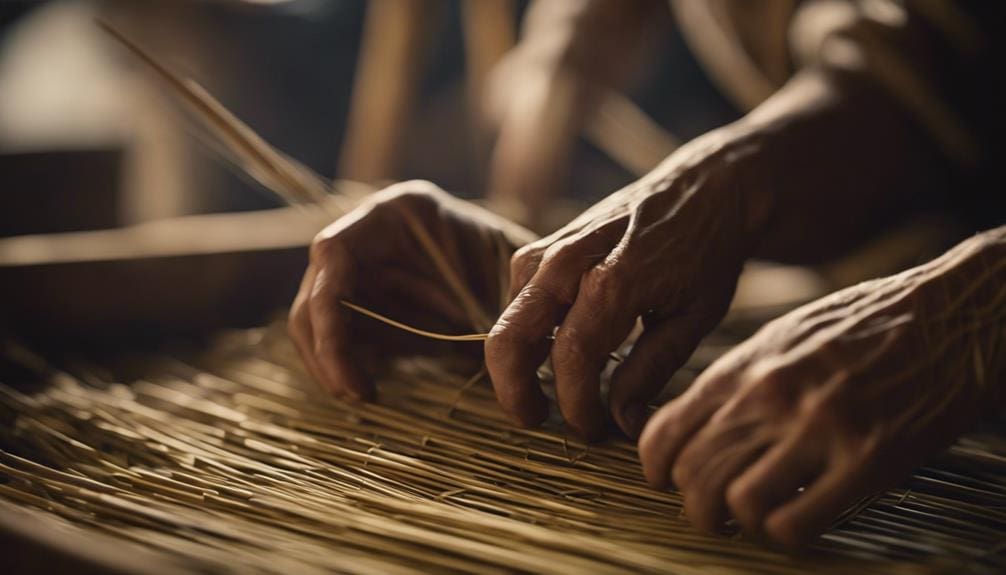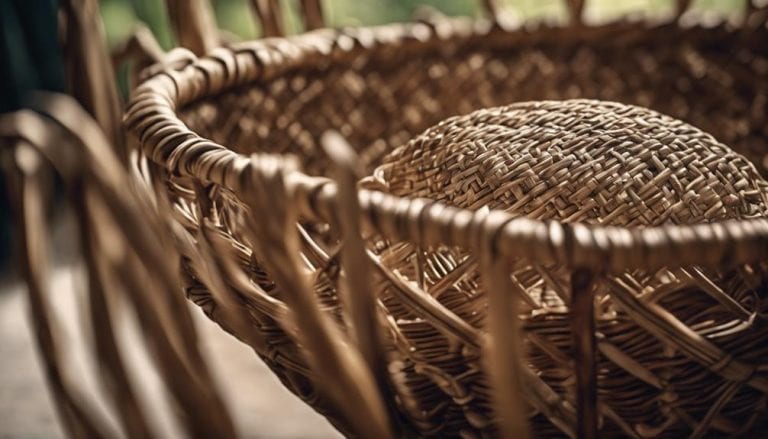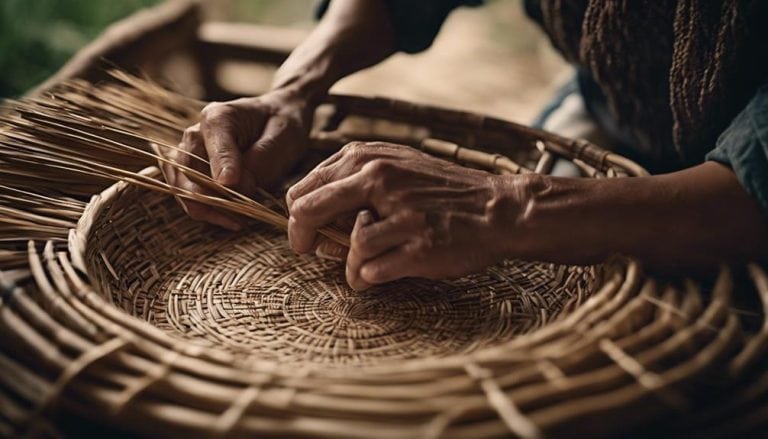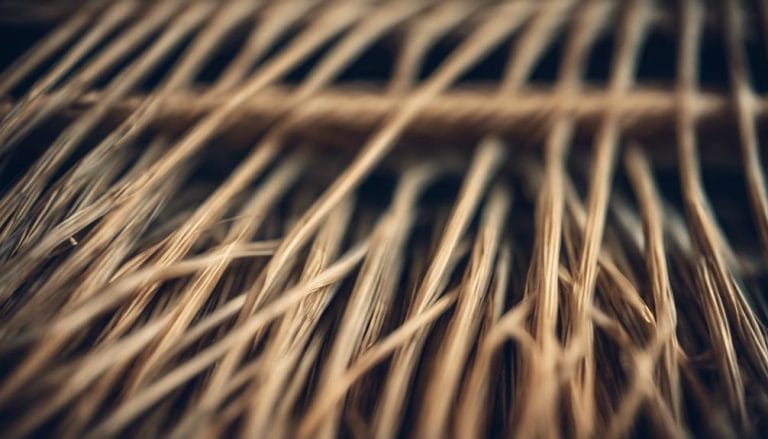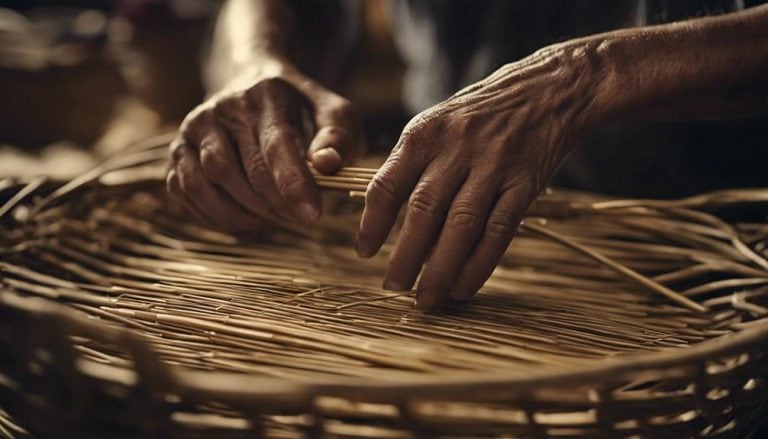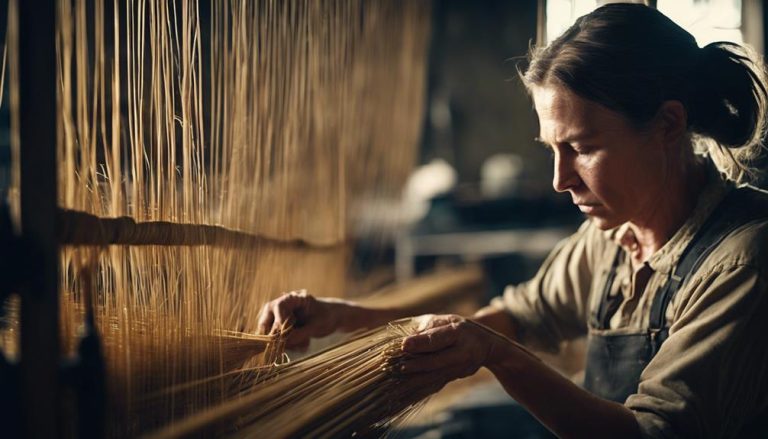Basket Weaving Techniques Using Rush Reeds
Did you know that rush reeds have been used for basket weaving for centuries, dating back to ancient civilizations? The intricate techniques of creating baskets are fascinating and practical.
From selecting the right type of rush reeds to mastering complex weaving patterns, a world of craftsmanship awaits exploration. Discover how these traditional techniques can be adapted to modern designs and how the art of rush reed basket weaving continues evolving.
Learn basket weaving techniques using rush reeds for a creative and traditional craft project. Rush reeds offer a versatile and natural material for crafting beautiful and functional baskets.
Key Takeaways
- Select long, straight rush reeds for smooth weaving.
- Soak rush reeds to enhance flexibility and prevent breakage.
- Incorporate intricate weaving patterns for visual interest.
- Attach handles securely and add decorative accents for a finished look.
Selecting the Right Rush Reeds
When selecting rush reeds for basket weaving, choosing those harvested in the late summer or early fall is crucial to ensure optimal flexibility and quality. Reed quality is paramount for successful weaving. The best rush reeds are long, straight, and consistently thick, allowing for a smooth and sturdy weave. Vibrant green rush reeds add to the aesthetics and impact the final basket’s design. Their strong and flexible nature makes them ideal for creating intricate patterns that stand out.
To ensure weaving success, inspect the rush reeds for any knots, blemishes, or mold, as these can hinder the weaving process. Opt for reeds free from imperfections to guarantee a seamless weaving experience. Additionally, properly dried rush reeds retain their natural color and strength, resulting in durable and visually appealing baskets. Selecting high-quality rush reeds sets the foundation for a successful and gratifying basket-weaving journey.
Preparing Rush Reeds for Weaving
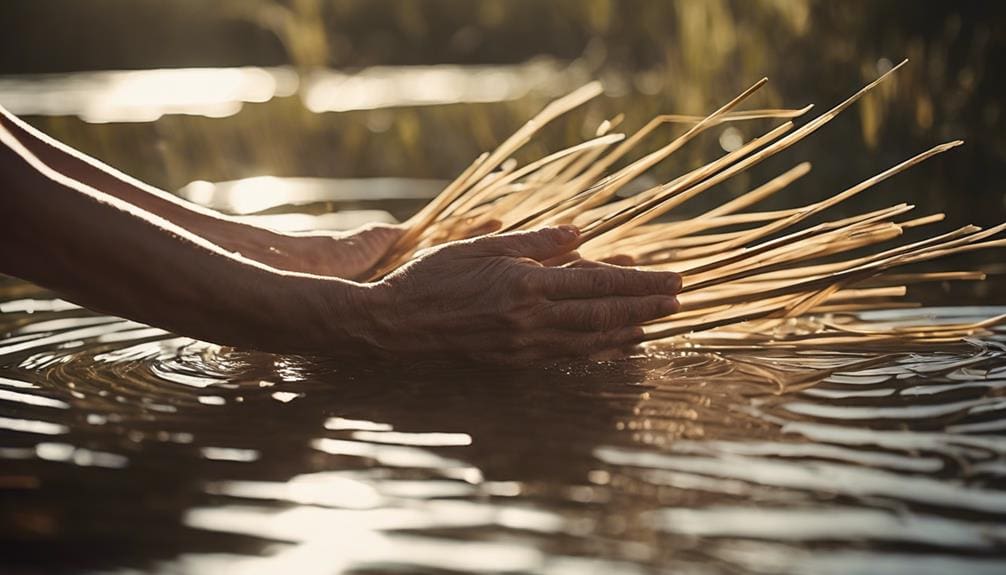
To prepare rush reeds for weaving, soak them in water to enhance flexibility and prevent breakage. This soaking process is crucial as it makes the rush reeds more pliable, allowing them to be woven without snapping. Once soaked, the rush reeds should be dried under shade to maintain their natural color and strength. Drying them carefully ensures they do not become brittle or lose their integrity, which is essential for creating a durable and visually appealing basket.
After the soaking and drying stages, sorting the rush reeds by size and quality is important. This step guarantees uniformity in the final product and makes the weaving process smoother. Additionally, skilled weavers may split the rush reeds into finer strands for more intricate weaving patterns and designs. By understanding these preparation techniques, we can fully appreciate the beauty and versatility of rush reeds in basket weaving.
Basic Basket Weaving Techniques
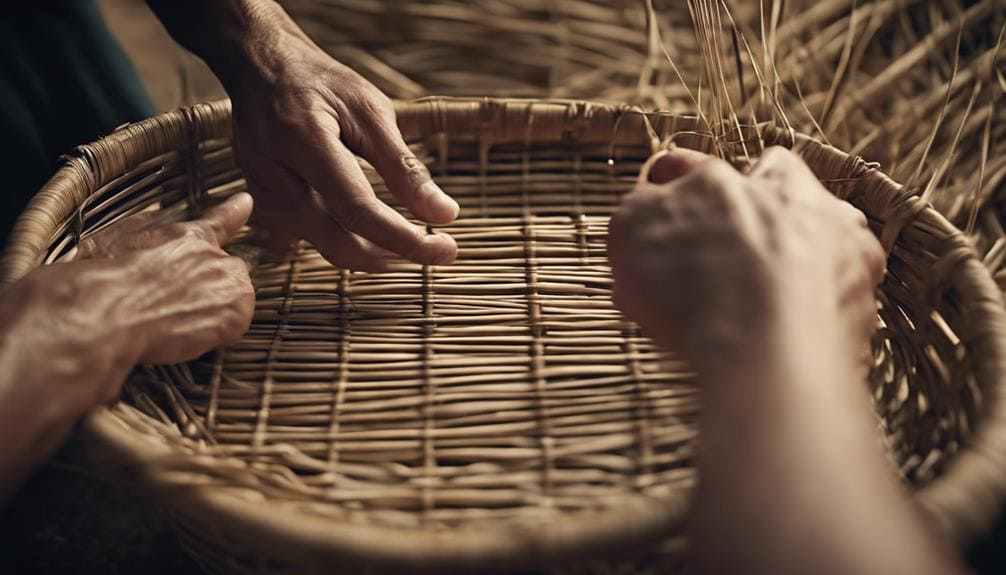
How can rush reeds be skillfully manipulated to form the foundation of a sturdy and aesthetically pleasing basket using basic weaving techniques? As a seasoned weaver, I’ve honed my skills to create beautiful baskets with traditional weaves and modern twists using rush reeds. Here are four key techniques to master:
- Start with a Strong Base: Craft a sturdy base by weaving rush reeds using a coiling method. This foundation is crucial for the overall strength and structure of the basket.
- Build Up the Sides: Use overlapping rush reeds to build up the basket’s sides gradually. Secure each row tightly to ensure a well-constructed and durable piece.
- Incorporate Different Weaving Patterns: Experiment with traditional weaving patterns to add visual interest to your basket. Mixing these patterns can result in a unique and aesthetically pleasing design.
- Consider Eco-Friendly Alternatives: While rush reeds are popular, explore eco-friendly alternatives like natural fibers or recycled materials to weave sustainable baskets with a modern twist.
Advanced Weaving Patterns and Designs
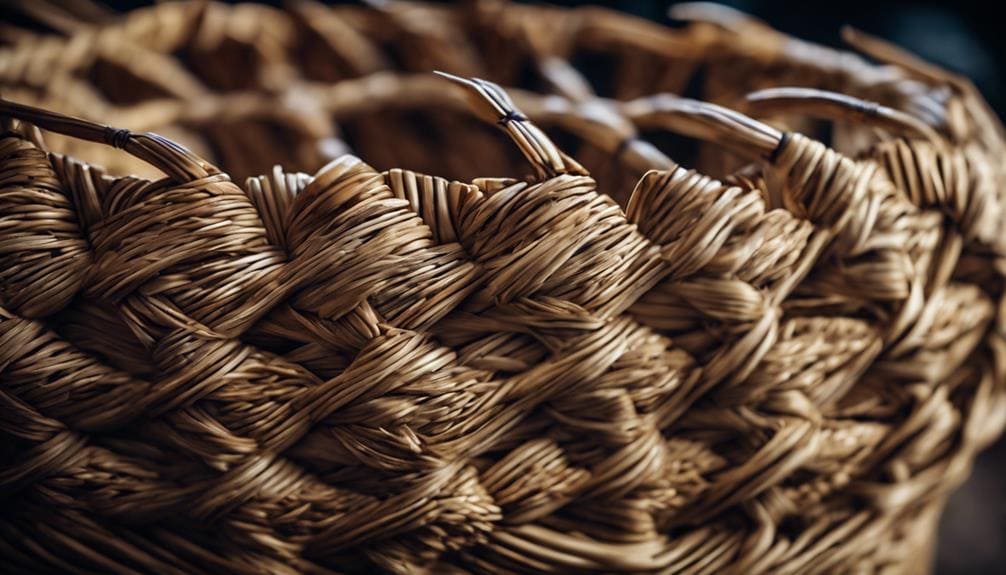
Having mastered the foundational techniques of rush reed basket weaving, the next level of expertise involves intricate geometric designs and nature-inspired motifs in advanced weaving patterns. Advanced weaving patterns in rush reed baskets blend traditional techniques and creative innovation.
Skilled weavers use techniques like twining, plaiting, and coiling to create complex designs ranging from simple stripes and checks to elaborate shapes like flowers, animals, and traditional symbols. These intricate motifs and nature-inspired designs add a unique charm to each basket, reflecting the weaver’s creativity and attention to detail.
Geometric patterns play a significant role in advanced rush reed basket weaving, requiring precision and expertise to achieve visually striking results. Weavers often incorporate multiple colors of rush reeds to enhance their designs’ complexity and visual appeal. Combining advanced techniques and thoughtful design choices results in beautifully crafted baskets that stand out for their artistry and craftsmanship.
Adding Handles and Finishing Touches
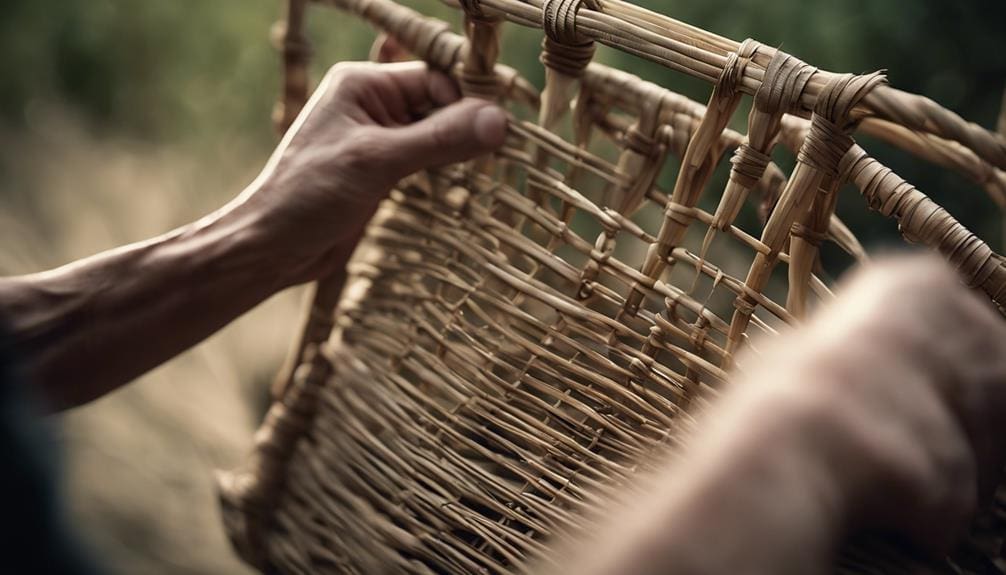
I skillfully attach handles to rush reed baskets, ensuring durability and functionality.
- Handle Attachment: I carefully weave the rush reed handles into the basket structure, ensuring they are securely attached to withstand carrying and usage.
- Decorative Accents: By incorporating different weaving techniques or adding colorful accents, the handles serve a practical purpose and enhance the basket’s overall aesthetic.
- Reinforcement: To enhance durability, I reinforce the attachment points of the handles by weaving extra reeds or using a sturdy binding technique.
- Finishing Touches: Trimming any excess reeds and smoothing out the edges give the basket a polished look, making it visually appealing and ensuring a uniform appearance.
Tips for Maintaining Rush Reed Baskets
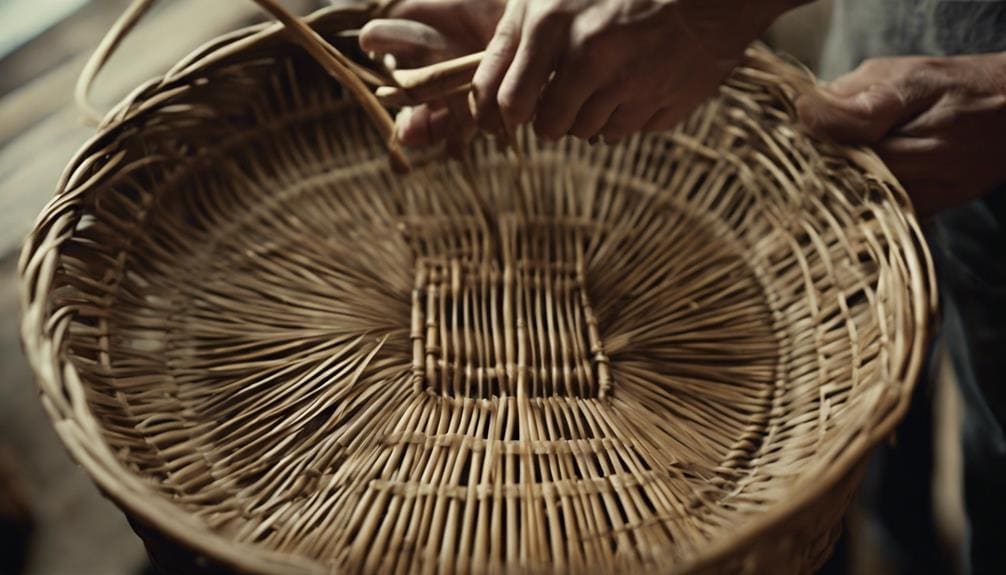
After skillfully attaching handles to rush reed baskets, ensuring both durability and functionality, maintaining these baskets is crucial for preserving their quality and appearance. To keep rush reed baskets in top condition, protecting them from direct sunlight is essential to prevent fading and drying out. Regularly dusting off the baskets with a soft cloth or brush will help keep them clean and debris-free.
Avoid placing heavy items in the baskets to prevent warping or damaging the structure. Storing rush reed baskets in a cool, dry place is key to avoiding mold growth and moisture damage. Consider applying a protective coating or sealant to the baskets for added durability and longevity.
If any damage occurs, it is important to repair damaged baskets promptly to prevent further deterioration. Embracing eco-friendly basket care practices sustains the baskets and aligns with a sustainable lifestyle, promoting the longevity of these beautiful creations.
Exploring Creative Basket Weaving Ideas
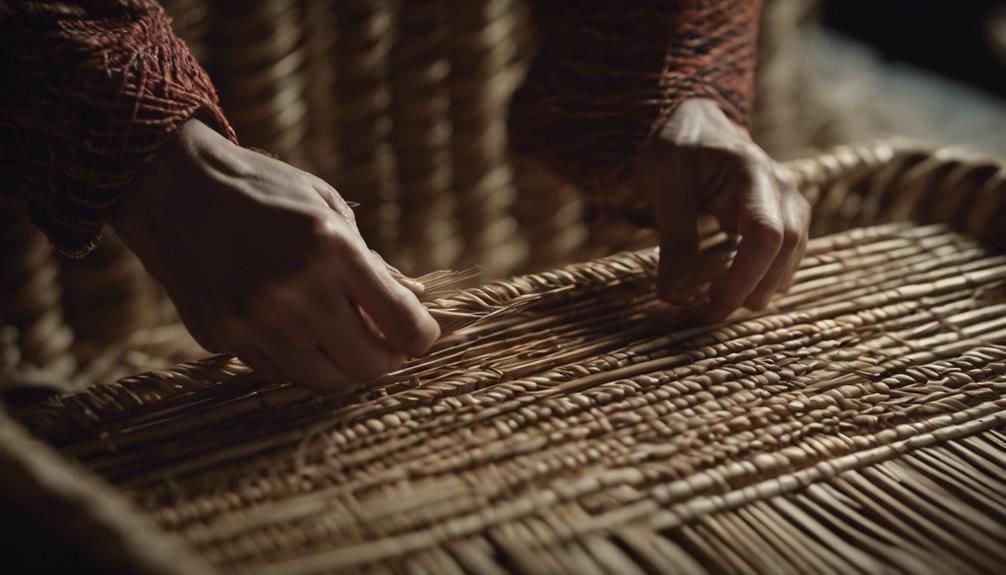
Exploring creative basket weaving ideas opens up possibilities for crafting intricate patterns and textures using versatile and durable rush reeds. When delving into the realm of imaginative basket weaving with rush reeds, here are some exciting concepts to consider:
- Colorful Combinations: Experimenting with diverse dye colors for rush reeds can lead to stunning and vibrant baskets that catch the eye and add a pop of personality to any space.
- Natural Inspirations: Drawing inspiration from nature can result in organic and harmonious designs that reflect the beauty of the environment, incorporating elements like leaves, flowers, or even natural dyes.
- Modern Twists: Infusing contemporary design elements and techniques into traditional basket weaving methods can create a fusion of old and new, resulting in unique and stylish pieces that appeal to modern tastes.
- Traditional Roots: Paying homage to traditional basket weaving styles and patterns while adding a personal touch can help preserve cultural heritage and create timeless pieces with a story to tell.
Frequently Asked Questions
What Are the 4 Techniques of Basket Weaving?
I know four techniques of basket weaving: coiling, plaiting, twining, and stake and strand. Twining patterns and decorative finishes enhance the baskets. I experiment with color combinations and basket shapes to create unique designs that express my creativity.
How Do You Prepare Rushes for Weaving?
To prep rushes for weaving, I harvest them in summer, cut them at the base, dry them for flexibility, soak them, trim leaves, and sort them by length/thickness. Soaking time softens rushes, making them pliable for smooth weaving.
How Long to Soak Reeds for Basket Weaving?
I find that 24 hours is a good starting point when soaking reeds for basket weaving. For intricate patterns, I recommend 48 hours for a softer texture—experiment based on reed thickness. Longer soaking means better flexibility and durability.
What Techniques Did Native Americans Use to Weave Baskets?
I learned various techniques from Native American tribes in weaving intricate baskets. Traditional patterns showcase cultural significance. Materials sourcing is essential for authenticity. Modern adaptations honor these traditions. The art of basketry unites past and present beautifully.
Conclusion
After mastering the art of basket weaving techniques using rush reeds, I am proud to share that this traditional craft is beautiful and sustainable. Did you know that rush reeds can grow up to 10 feet tall in just one year, making them a renewable resource for crafting? Embracing these techniques creates stunning baskets and supports eco-friendly practices for a greener future. Happy weaving!

